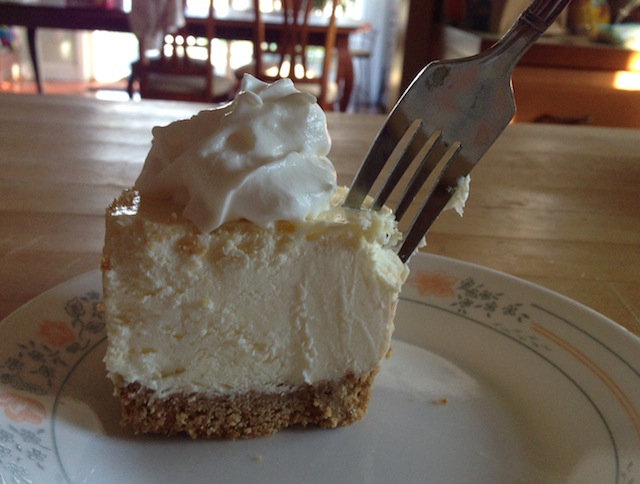My mum still makes it in a pie plate (and I do a well). More graham cracker crust, and a thinner filling, like you said.
And we always have fruit on top. Usually cherry pie filling; sometimes peach or apricot jam. Fresh berries if in season.
My mum still makes it in a pie plate (and I do a well). More graham cracker crust, and a thinner filling, like you said.
And we always have fruit on top. Usually cherry pie filling; sometimes peach or apricot jam. Fresh berries if in season.
A friend made a cheesecake in college, in a real spring pan, using a very large toaster oven. It took much longer to cook than he expected. He’d take it out, test it with a toothpick, then put it back. Each time it settled more. By the time it was done, it was the densest, neutron star material cheesecake I’ve ever tasted. It was really good.
Does the layer of sour cream+sugar on the top count as frosting?
(Just made a cheesecake for the first time today. It was a little too tall and overflowed the springform pan it was in while baking. I either need a taller pan or should make New York style cheesecakes).
This recipe was given to me by a friend and it is AMAZING. I make the crust (she made graham cracker crust, but I really like this one). I didn’t have the sauce part and have never made that.
This is just a classic New York cheesecake. It is so good.
The only thing with this recipe is it always takes way longer to cook than the recipe says it will. Like, by an hour.
That has got to be the longest list of steps I’ve ever seen. 
Possibly best to fork this thread, so if some readers (like me!) want to follow science news, or news about science, or new about possibly untrue science, then we don’t have to read about the gorram cheesecake.
Shorter version of same recipe.
If we’re talking about cheesecake, we have to at least mention Japanese cheesecake:
Mmmmm, fluffy.
I see what you did there. 

About half the instructions seem to be about making the crust. I made a graham cracker crust, which is basically, “mix the ingredients until homogenous, press into the bottom of the pan and up the sides, then bake at 375 for 10 minutes”.
I think “cheesecakes” are harder to get right than “New York cheesecakes”… New York Cheesecakes don’t have any “fold beaten egg whites into the batter” stuff and there doesn’t seem to be any of the usual “bake until only the center jiggles when the pan is disturbed. But don’t disturb the pan. Use a water bath.” Yeah, I’m gonna make a New York cheesecake with a graham cracker crust next time for sure.
It suddenly occurs to me that either I’ve been extraordinarily lucky, or I have absolutely no discerning taste, or it’s flat impossible to screw up a cheesecake. It’s probably the second. But regardless, I have never once had a bad cheesecake. Not even slightly disappointing.
All the “bad” cheesecakes I’ve had have been overdone, not in the baking but in the flavouring. Too much sugar, or too much lemon, or too many toppings (probably with too much sugar).
This thread is not what I was thinking… but I have to agree with @chgoliz about proper cheesecake.
On Long Island we have all these Italian restaurants (due to having lots of Italians here), and I really like the Italian cheesecake, which is made with ricotta cheese. It’s a bit dryer than a New York cheesecake and not as dense.
Here I am, reading all these discussions about cheesecake-making and thinking that the topic is perfectly science-y. Thick vs thin! Ricotta vs cream cheese! Eggs or no eggs! Cooked under vacuum! Pyrolysed in a kiln under nitrogen?
Not to mention baking, chilling, freezing, or bake-then-freeze.
The sous vide thing, I would argue, produces pudding, and not cake as such. This is not a bad thing, just a different thing.
Add some trimethyl borate to the cheese mix, and pyrolysis under nitrogen will probably give you a pretty good ceramic…
…hell, I’d try it.